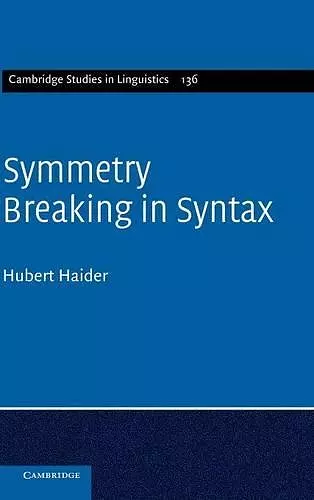Symmetry Breaking in Syntax
Format:Hardback
Publisher:Cambridge University Press
Published:13th Dec '12
Currently unavailable, and unfortunately no date known when it will be back
This hardback is available in another edition too:
- Paperback£30.99(9781316604809)

A new theory of grammar which explores the old distinction between OV and VO languages and their underlying basic asymmetry.
In this illuminating new theory of grammar, Hubert Haider explores the basic asymmetry in the phrase structure of any language, whatever sentence structure it takes. He identifies a new third type of sentence structure, in addition to object-verb (OV) and verb-object (VO), and uses it to explore the cognitive evolution of grammar.In this illuminating new theory of grammar, Hubert Haider demonstrates that there is a basic asymmetry in the phrase structure of any language, whatever sentence structure it takes. Moreover, he argues that understanding this asymmetry is the key to understanding the grammatical causality underlying a broad range of core syntactic phenomena. Until now, Germanic languages have been seen to fall into two distinct classes: those which take an object-verb sentence structure (OV) or a verb-object one (VO). However, by examining the nature of this universal underlying asymmetry, Hubert Haider reveals a third syntactic type: 'Type III'. In particular, he employs the third type to explore the cognitive evolution of grammar which gave rise to the structural asymmetry and its typological implications. Symmetry Breaking in Syntax will appeal to academic researchers and graduate students involved in comparative and theoretical syntax and the cognitive evolution of grammar.
'Professor Haider's Basic Branching Constraint is a bold solution to the problem of word order and word order correlations in language … should be read and taken seriously by grammarians of all stripes.' Frederick J. Newmeyer, Professor Emeritus, University of Washington
'There's a big idea at the core of this book, that natural languages have only right-branching structures: left-branching structures do not exist. Haider explored this idea in his 2010 Syntax of German, showing that it led to productive analyses for German, but here he takes things to a new level and examines consequences for analyses in a range of languages and compares his proposal to related ideas in other theoretical models.' David W. Lightfoot, Georgetown University
ISBN: 9781107017757
Dimensions: 231mm x 150mm x 20mm
Weight: 550g
284 pages